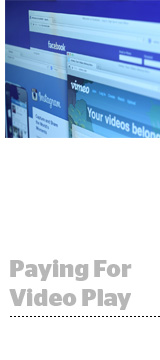 Video publishers are clamoring for a clearer monetization plan from Facebook.
Video publishers are clamoring for a clearer monetization plan from Facebook.
The social network does not yet have a revenue-sharing arrangement, however, which is challenging for publishers who want to measure the value of their cross-platform distribution efforts.
“It’s a problem, since there’s no monetization for video yet, but it is coming,” said Nathan Brown, SVP and GM for video at The Huffington Post, speaking Wednesday at LDV Capital’s Vision Summit in New York.
He added: “Facebook will scale a massive audience and flip the switch much like they did in the past, and you already see some post-roll stuff they’re doing with NFL content. Very soon there will be beta monetization structures with publishers like ourselves.”
But if history rewrites itself, video could follow the path of early Facebook brand activity. Initially, marketing messages saw massive audience scale – until Facebook reduced organic reach in exchange for a paid model based around perks like performance.
Tom Wilde, CEO at video platform company RAMP, said large media companies are too focused on the revenue and performance part when they should first negotiate what data Facebook provides back on shared content.
“The value exchange should be, ‘I need data behind the click in order to create more content that’s relevant to your audience while learning more about mine,’” he added.
Inbar Barak, SVP of digital programming and strategy for Martha Stewart Living Omnimedia, said the home and lifestyle publisher would benefit from deeper metrics beyond the click. Barak said Facebook video is great in terms of audience development, but she would like additional visibility into other metrics, such as overlap with other channels.
“If you could focus on click-per-view, you could make money off of Facebook and be distributing and monetizing successfully,” Barak said. “Clicks are clicks and watch time is watch time, so once you can get audience metrics and data around it, we can use that to [influence] what we create and renew [with content].”
Wilde said the economic model for TV has been inverted. Consumers used to tune into programming scheduled on a select day and time. Now, content is looking for users.
“Facebook used to be about optimizing for brand first and find the audience after, now you have to begin with optimizing for their audience first,” he said.
Although the reach potential is great – Facebook has 1.4 billion registered, active users – publishers still wonder if their third-party distribution efforts will ultimately undercut their owned-and-operated initiatives.
“The whole idea of understanding customer behavior and customer data is difficult when you use an audience distribution platform,” Barak said. “You may try to match up with another person’s taxonomies, and combine that with your own tags and metadata, but it’s not a perfect match.”
And the inability to extract data from Facebook – specifically tying social back to ROI or brand lift – irritates publishers who want to sell advertising directly.
“It’s frustrating for me to go into a room and sell Facebook before I can sell the company I want to sell,” said Chad Smolinski, SVP at U.S. News & World Report, during a Daily News Innovation Lab panel Tuesday. “I have to sell the concept of social.”
But NowThis News’ VP of social media, Ashish Patel, speaking at the same panel, indicated this might be the new normal.
“We’re no longer in control over the marketing and how the advertising works,” he said. “That’s both an opportunity to leverage the scale, reach and speed of Facebook, but it also takes publishers further away from the customer. That’s something we’ll all, as an industry, will have to grapple with.”
And for many publishers – National Geographic, BuzzFeed and The New York Times among them – the allure of brand-building and new traffic referrals from an audience of that scale is too hard to resist.
“One issue with social is you need to find the right balance between discovery and monetization,” pointed out Michael Hsu, PopSugar’s head of video business development, during a panel Tuesday at the JW INSIGHTS video conference.
For instance, NowThis News, which provides news bites in 15-30-second clips and had 140 million video views across all its platforms in April, doesn’t even have its own website, instead distributing via social media and syndicating content to other publishers like MSN or Yahoo.
Yet the network only monetizes 20% of its video, said Patel, in part because it’s not appropriate to sell advertising against some of NowThis’ heavier news content.
Another example of the clear division between discovery and monetization: PopSugar has partnered with YouTube for several years, but Facebook surpassed it in March as its largest social platform distribution partner. But it’s not necessarily an apples-to-apples comparison, since video development efforts vary greatly from Facebook to YouTube.
For the former, PopSugar develops video under the assumption that the sound will be off and the user will be scrolling.
Thus, it focuses on short, snackable videos with attention-grabbing graphics. On YouTube, viewers tend to be more engaged, since they’re not accessing videos through a feed, so PopSugar focuses on more personalized storytelling there, Hsu said.
“We’re making zero money from Facebook, but it’s about getting your content out there,” Hsu said. In some cases, the potential for referrals (349 million click-throughs per month now from Facebook to BuzzFeed) and social shares (PopSugar has raked in a total of 300,000-400,000 shares for some video posts) is too hard to pass up.
Much of the excitement around video has to do with its massive potential. But Smolinski wondered if there could be a point of diminishing returns – even as more outlets like Facebook try to court video publishers.
“When everyone is doing
in such high volumes, it’s hard to do two things: sustain your scale and it’s hard to monetize, because there are so many places for marketers to go,” he said.
Ryan Joe contributed.













